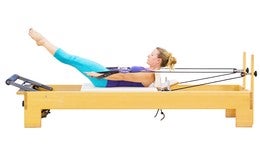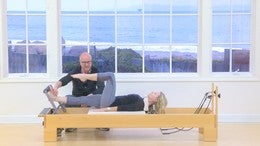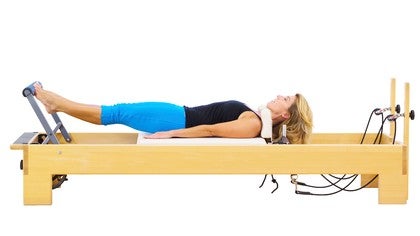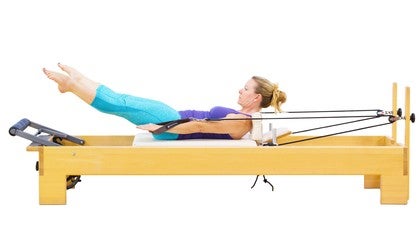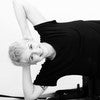Description
Muscle Focus: Legs.
Objective: Aligning the body and strengthening the legs.
Reformer Setup: Start with two to four springs depending on the amount of resistance desired. The footbar is up and the headrest is up.
Start Position: Lie supine on the carriage with the head on the headrest, maintain a neutral pelvis and spine, and place the feet on the footbar.
Movement:
Toes: Place both toes onto the footbar a fist distance apart, with heels glued together and lifted about four inches away from the bar. Knees are shoulder distance apart. Keeping the heels together and in the same position, press the legs to straight as you find an external wrap of the thigh muscles. Bend the knees to come in without changing the position of the feet. Repeat nine more times.
Arches: Place both arches of the feet onto the footbar, with feet and legs zipped together. Curl the toes over the footbar as the heels reach under the footbar. Press the legs to straight without changing the position of the feet. Bend the knees to come back in. Repeat nine more times.
Heels: Place both heels onto the footbar, with feet and legs zipped together. Flex the feet - the toes will reach straight up to the ceiling. Press the legs to straight without changing the position of the feet. Bend the knees to come back in. Repeat nine more times.
Tendon Stretch: Place the balls of the feet on the footbar, one inch apart, with the heels together and lifted. Externally wrap the thigh bones. Press the legs out to straight. Keeping the legs straight, lower the heels under the footbar for three counts, and lift the heels for three counts. Repeat three to five more times.
Precautions: Avoid hyperextension of the legs by finding control of the movement from the backs of the legs. Focus on ensuring that the alignment of the knees and ankles are not compromised by rolling out or in with the ankles and knees.
About This Video
Transcript
Read Full Transcript
Hi everyone. We're here to take a look at some reformer exercises. We'll be starting with footwork today and I want to first go through a general set up for your footwork position. So I like to think of the body being very centered between the shoulder rests. So head right between the two. You're not too far on the right side of the reformer, not too far on the left side. Your body's nice and long pelvis is level, so we don't have too much of a tilted Undertale and not too much of a overextended tail. So good neutral alignment.
So an objective for footwork in my opinion, is overall alignment of the body and we're working to align our joints and our bones in those joints. So the first position we're looking at is the Palladia is v very often the first one in your reformer workout. The position of the knee with here is very uh, precise. We want to align the center of the knee cap up with the second toe, and that usually is with the width of a person's shoulders. Now keep in mind that might be slightly different for everybody.
Some people have a bow legged alignment. Some people have different feet in Bunyan's and things, but that's our general setup that we want to look for. Again, the objective here is to start warming up, work on alignment, and start feeling the muscles of the legs getting activated. So I'm going to have Christie begin to move. Her heels are pressed together. Who's on the balls of the feet? She inhales as he, she stretches and exhales to come in. It's important to feel the back of the legs a little bit more than the front of the legs or the front of the thigh and that sense of, go ahead and pause for one second. The side here, the legs wrapping to the back of the thigh and underneath and into the inner thigh. So there's a very strong connection from the heels.
Squeeze all the way up. It's very much in line with our spine. She'll keep going through this about five or six more other things to be mindful of the, with the knees, there's something called hyperextension, which is overextending the knee and pressing too low there. She showed a good example of hyperextension, so how to control that is again with the back of the thighs, those strong hamstrings to support the alignment of the knee and the joints of the knee. One more time she extends and she comes back in. Next position we'll look at it is the prehensile or arches position. It's in parallel now so we have a more of a leg to leg alignment and you'll notice you're going right on the arch of the foot versus kind of gripping with the Tozier there.
That's not quite where we're looking for looking right at the base of the metatarsal is in the arch. Toes are relaxed but yet long over the bar. We want that sense almost like if my hands cupping this way that that's Christie's foot doing the same thing over this bar. Heels are also kind of downish rather than up in the first position, so we have a little difference there. Same muscle focus from the back, the thighs, pelvis, still level. She inhales as she extends and Xcels to come in, feel for even use of the feet against the bar, meaning even weight through both legs.
You may feel that you're biasing or using one leg more than the other, so feel free even and balanced a work in your legs. She's keeping her pelvis level, her rib cage relaxed. This is also starting to open up alignment across the chest, although we're not thinking about that during footwork all the time, but that's part of our alignment as we stand on our two legs is focusing on our posture. Let's shoot for one more inhale as you extend an exhale, as you come back in. Third Position we'll look at are the heels and so she lifts her feet and sets those. The center of the heel bones right on the bar.
Ankles are together inside. Seam of the foot is together, chose or pointed straight up to the ceiling. There's quite a bit of energy in the ankle, joint knees together. Now I want to put my hands here at the base of Christie's feet and kind of pretend to be her floor. Like I'm on the floor. She's on the floor here. You may see differences along your classes and different teachers of moving the ankle and rocking a little bit or increasing the flection. But for this purpose will keep the feet here. Same thing, press away as you inhale. Exhale accents.
We're keeping a mind on that lack of not hyperextending the knees. She's using the back of those legs to help align the thighs, keeping those ankles inflection the toes right up to the ceiling. That good level position in neutral spine. So again, see we're really standing on that bar and moving our legs and how that echoes that alignment all the way through our body. So from the feet up, let's go with one more Christie and then pause. Final position today is the Achilles' tendon stretch or heal lower lift, the changed position. We'd go to the balls of the feet again.
Well balls and feet, toes, slightly relaxed, but yet there might be slightly touching the bar. And I want you to lift your heels and keep in mind that we are looking for balance on the feet. So if you lift your heels watching out that you don't roll out on the outside edge such as that or knocked too far in, you may have to limit how high you take your heels for that, but ideally heels are lifted. That same wrap of the legs, that same initiation from the backside. Inhale, as you lengthen, you'll pause. Now this is a key point to watch out for those hyperextended knees, which could really show up. You're about to lower your heels with control. Let's take three counts to lower toward my hand.
Three and rise to three lower, lower, lower and lift. Lift. This is a good way to start I think. So you learn to control how you lower your weight app from that ankle joint rather than a sudden drop and she may show us one sudden drop here. Less of that more. Yes, less of that. More control. It's very elastic and strong. Same with the rise. It's not such a sudden pop up, but rather that slow controlled lift, lift, lift. Let's do it two more times. Down, down, down Rye.
She's staying balanced on those feet. Notice that she's not rolling out on the outside edges or too far in hold right there and just take a notice of Chrissy's whole body has stayed very level. Her spine is state long, pelvis level. Her ribs haven't done a thrust or an arch, which she may show us here real quick, just to air. Pelvis hasn't shifted. She's got a good sense of alignment from her feet all the way up, which is a great way to start any Polonius workout and she'll bend your knees to finish. That's a real general look at the foot work. And again, you may see variations with your teachers, uh, eventually some single leg pieces as well.
But that's what we've chosen to show you that the today. Thank you very much.
Return to Life - Playlist 2: Reformer Exercises
Comments
You need to be a subscriber to post a comment.
Please Log In or Create an Account to start your free trial.
